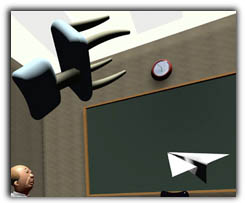The New Tort of Negligent Supervision
By Arnold Anderson
Editor's Note: To view Wisconsin statutory
materials referenced in this article you must have and/or install
Adobe
Acrobat Reader on your computer.

In Miller v. Wal-Mart Stores
Inc.,1 decided June 24, 1998, the
Wisconsin Supreme Court established the tort of negligent supervision in
Wisconsin. On the same day Miller was filed, the Wisconsin
Supreme Court also handed down Doyle v.
Engelke,2 which held the insurance
company had an obligation to defend the allegation of negligent
supervision.
Miller and Doyle establish the elements of the tort
of negligent supervision and its application to a liability insurance
company's duty to defend. However, much work remains before all the
ramifications of these two decisions will be known. This article
outlines considerations surrounding negligent supervision claims and
what happens when insurance questions are raised in the same case.
Theories of employer liability
With the Miller decision, there now are at least three ways
in which an employer can be held liable for the acts of employees: 1)
negligent supervision; 2) respondeat superior; and 3) an
employer who "knew or should have known" of the employee's tortious
conduct.
Recent court decisions establishing the tort of negligent
supervision will impact employer liability and insurance coverage. This
article outlines considerations surrounding negligent supervision claims
and what happens when insurance questions are raised in the same
case.
Negligent supervision. In Miller, Wal-Mart
employees stopped Miller, accused him of stealing a swimsuit, and also
created a ruckus in the store's parking lot. No swimsuit was found on
Miller. Miller filed an action against Wal-Mart Stores Inc. alleging
that the employees unlawfully stopped, detained, searched, and
interrogated him, which caused damages. The jury found that Wal-Mart was
not liable, through the acts of its employees, for false imprisonment,
battery, negligent infliction of emotional distress, and loss of
consortium claimed by Miller's spouse. However, the jury found that
Wal-Mart was negligent in hiring, training, and supervising its
employees and that this negligence was a cause of damage to Miller. The
jury also found that Wal-Mart did not have reasonable cause to believe
the Miller carried away or concealed unpurchased merchandise, and
awarded $20,000 compensatory and $30,000 punitive damages. The trial
court entered judgment on the verdict and the court of appeals certified
the case to the Wisconsin Supreme Court. The issue was whether the
employer had a duty of care with regard to hiring, training, and
supervising employees. Miller held there was such a duty.
For the duty to apply, first it must be foreseeable that employees
entrusted with specific duties and authority be properly trained and
that the failure to do so could result in harm to patrons. Second, if
the employer fails to properly hire, train, or supervise employees, it
breaches its duty to others. Third, there must be a causal connection
between the conduct and the injury. Two questions are necessary to
establish causation: Was the employee's wrongful act a cause in fact of
the plaintiff's injury? Was the employer's negligence a cause in fact of
the employee's wrongful act?
The jury in Miller found the employees were not liable for
false imprisonment, battery, or negligent infliction of emotional
distress and loss of consortium. However, the jury found Wal-Mart
negligent in hiring, training, and supervising the employees and that
this negligence was a cause of damage to Miller. Wal-Mart argued that if
negligent hiring, training, and supervision was a tort, it should
include an element that an underlying tort be committed by the employee.
Since the employees in Miller were found to be not liable, then
strictly speaking, there was no underlying tort committed by the
employees. All of the cases discussing negligent supervision cited in
Restatement (2d) of Agency, section 213 (1957), involved employees who
had committed a tort or actionable conduct against the plaintiff.
Miller sidestepped that issue. Miller did not require
an underlying tort: It simply held that a wrongful act is required and
the wrongful act need not be a tort. There was a wrongful act by the
Wal-Mart employees, which was the basis for the tort of negligent
supervision claim. In this fashion, Miller navigated around the
fact that the jury exonerated the employees of any tort.
The case was remanded to determine whether the elements of the tort
of negligent hiring, training, and supervision outlined in
Miller could be met. There was no remand with regard to the
damage issues, and that portion of the verdict was affirmed. Wal-Mart
also had invoked section
943.50(3) of the Wisconsin Statutes, which immunizes a merchant from
civil and criminal liability if the merchant "acts in good faith and any
act authorized under this section is immune from civil or criminal
liability for those acts." The jury determined that Wal-Mart did not
have reasonable cause to believe that Miller had shoplifted, and that
part of the verdict was affirmed. Miller also noted that, in an
appropriate case, if a merchant is liable for negligent hiring,
training, or supervision, the merchant nevertheless may be immune from
liability if the merchant meets the elements ofsection
943.50(3).
Respondeat superior. Miller
outlined the necessary elements of negligent supervision. In addition to
the tort established in Miller, the principles of agency law
also may apply to an employer. Agency law imposes vicarious liability on
an employer if an employee is acting within the scope of employment.
Thus, in addition to tort law, principles of agency law may impose
liability on an employer.
 "Therefore, a claim for negligent supervision is distinct
from a claim for vicarious liability, in that the former is based on
tort principles and the latter is based on agency principles. More
specifically, with a vicarious liability claim, an employer is alleged
to be vicariously liable for a negligent act or omission committed by
its employee in the scope of employment. See Shannon v. City of
Milwaukee, 94 Wis. 2d 364, 370, 289 N.W.2d 564 (1980)."3
"Therefore, a claim for negligent supervision is distinct
from a claim for vicarious liability, in that the former is based on
tort principles and the latter is based on agency principles. More
specifically, with a vicarious liability claim, an employer is alleged
to be vicariously liable for a negligent act or omission committed by
its employee in the scope of employment. See Shannon v. City of
Milwaukee, 94 Wis. 2d 364, 370, 289 N.W.2d 564 (1980)."3
The liability of an employer for the acts of a servant within the
scope of employment has been around for more than 100 years:
"In such a case, where the wrongful act of the servant, though
wilful, is strictly within the scope of his employment, it is
unnecessary that the master should be at the same time sanctioned nor
subsequently ratified of the unlawful act, in order to be held liable
for mere compensatory damages ... this is upon the theory that what one
does by his servant acting within the scope of his employment and for
his benefit is the same, in legal effect, as though done by
himself."4
Arsand v. City of Franklin5reiterated that when respondeat superior
applies, the master must pay for the torts of the servant. Agency law
will "let the master answer."6
The difference in applying respondeat superior and negligent
supervision is best illustrated by a hypothetical. Assume the plaintiff
was a bar patron and was disturbing patrons by being loud and obnoxious.
The bartender-enforcer (employee) got sick of the plaintiff's antics and
slammed the plaintiff up against the wall and slapped the plaintiff
across the face three or four times causing injury. If the bar owner had
instructed the bartender-employee that the bar has a "get tough" policy
with loud and obnoxious patrons, and the only way to handle them is to
slap them around, then the employee probably was acting within the scope
of employment. Vicarious liability (respondeat superior) would
attach and the owner is liable. Assume further, however, that the
bartender's conduct was so outrageous as to not be considered within the
scope of employment. With the new tort of negligent supervision, the
employer-owner of the bar still may be found liable for negligent hiring
(didn't check to find out if the bartender had done this before);
negligent training (hadn't told the bartender not to slap people
around); or negligent supervision (turned the bartender loose without
any monitoring).
"Knew or should have known" standard. L.L.N. v.
Clauder involved negligent supervision of priests. L.L.N.
also set out a standard of care for negligent supervision, which appears
to be a separate basis upon which liability of an employer can be
based:
"Therefore, an employer is liable for negligent supervision only if
it knew or should have known that its employee would subject a third
party to an unreasonable risk of harm."7
This is a third avenue of liability against an employer. The "knew or
should have known" standard probably is harder to establish in most
cases than the tort outlined in Miller. However, there may be
circumstances where the plaintiff will want to apply the "knew or should
have known" standard, particularly if the level of culpability is
important and punitive damages are being sought. The "knew or should
have known" standard also may be relevant to insurance coverage
issues.
In the hypothetical concerning the bartender (employee) and the bar
owner (employer), if the incident with the plaintiff was the second or
third time the bartender had slapped someone around, the court or jury
probably could find that the facts come within the "knew or should have
known" standard, and liability would be imposed on the employer without
the necessity of establishing negligent hiring, training, or
supervision.
Verdict form. Litigants in Wisconsin now have at
least three theories of recovery against an employer when dealing with
employee conduct: 1) the tort of negligent supervision; 2)
respondeat superior, that is, the employee acting within the
scope of employment when the damage was inflicted; and 3) the employer
"knew or should have known" that the employee would subject a third
party to an unreasonable risk of harm.8
The basic verdict questions concerning negligent supervision
follow:
1) Did the employer have a duty to properly hire or train or
supervise the employee? If so,
2) Did the employer breach that duty? If so,
3) Was the employee's wrongful act a cause in fact of the plaintiff's
damages? If so,
4) Was the employer's negligence a cause in fact of the employee's
wrongful act?
5) What amount of money will fairly and reasonably compensate the
plaintiff for damages sustained as a result of the employee's (or
employer's) conduct?
The doctrine of respondeat superior could add another
question to the verdict:
6) Was the employee, at the time of his or her conduct, acting within
the scope of his or her employment?
If the answer is yes, there may be no need to go into issues of
negligent hiring, training, and supervision. The conduct of the employee
within the scope of employment is conduct of the employer.
Finally, if applicable, the jury also may be asked if the employer
"knew or should have known" the employee would cause harm or
injury.9
Insurance coverage
In Doyle v. Engelke, 10 a claim for negligent supervision in the
complaint was sufficient to trigger the duty to defend. This case arose
out of an anti-abortion demonstration. One of the defendants, Ward
Engelke, had allegedly accused the plaintiff, Catherine Doyle, of
cursing at and kicking at his daughter in the face while his  daughter was praying outside of a clinic. Engelke's claims
had been covered in the print media and by a radio station owned by
defendant Wisconsin Voice of Christian Youth Inc. (WVCY). The complaint
also alleged that two WVCY employees filed a false security agreement
with the Secretary of State encumbering the Doyle's assets and also
served a false subpoena at Doyle's residence. The insurance policy at
issue in the appeal was a commercial general liability policy issued to
WVCY.
daughter was praying outside of a clinic. Engelke's claims
had been covered in the print media and by a radio station owned by
defendant Wisconsin Voice of Christian Youth Inc. (WVCY). The complaint
also alleged that two WVCY employees filed a false security agreement
with the Secretary of State encumbering the Doyle's assets and also
served a false subpoena at Doyle's residence. The insurance policy at
issue in the appeal was a commercial general liability policy issued to
WVCY.
Numerous causes of action were alleged against WVCY and its
employees. By the time the case reached the Wisconsin Supreme Court, the
only claims for insurance coverage were a slander of title claim and
negligent supervision. Doyle held the slander of title claim
was not covered; hence, all the underlying conduct alleged in the
complaint was excluded by the insurance policy. This left the negligent
supervision claim against the employer, and this allegation triggered
the insurer's duty to defend.
The trial court and the Wisconsin Court of Appeals had both held that
the insurance company had no obligation to defend in Doyle.
Both courts stated that the intentional acts of employees acting within
their scope of employment were intentional acts of the employer. This
brought the employer within the intentional acts exclusion. The
Wisconsin Supreme Court did not deal directly with the respondeat
superiorissue, but stated:
"We disagree with the form of the analysis offered by the Court of
Appeals. It is significant in this case that the coverage disputed by
the parties is not St. Paul's obligation to defend WVCY employees
individually for their intentional acts against Doyle. Rather, the
coverage we are addressing is WVCY's individual coverage as a protected
person under the policy."11
In footnote, the supreme court noted the vicarious liability argument
of the insurance company:
"Moreover, St. Paul's objection to responsibility to defend WVCY
against the negligent supervision claim on vicarious liability grounds
fails to recognize that it is not a claim for vicarious liability. While
negligent supervision does require an underlying wrong to be committed
by the employee as an element, the tort actually focuses on the
tortious, i.e., negligent, conduct of the employer." 12
There was no further analysis of respondeat superior theory
nor was there any discussion of cases where the employer-insured "knew
or should have known" of the employee's conduct.13 There also was no mention of cases such as
Bankert v. Threshermens Mutual Insurance Co. 14 Bankert held there was no obligation to
defend an insured for negligent supervision of children that culminated
in damages caused exclusively by the use of an automobile that was
excluded by the policy.
Keep in mind that Doyle was a duty to defend case, and the
complaint was construed in favor of the insured.Doyle gave the
allegation of negligent supervision its narrowest meaning because this
was most favorable to the insured.
Checklist of issues
Since the Doyle approach was narrow, there remain issues
that will have to be considered when litigating an employer's conduct
and matching that conduct to an insurance policy to see if there is a
duty to indemnify, as opposed to a duty to defend. This section
discusses some of those questions.
 Was the employee acting within the scope of
employment? If an employee's conduct that gives rise to damages
is within the scope of employment, respondeat superior should
apply. The conduct of such an employee becomes the act of the employer.
15 For example, the employee's intentional
acts will also be the employer's intentional acts and excluded by an
insurance policy's intentional acts exclusion. The insured employer will
be acting intentionally due to respondeat superior; thus, there
should be no coverage for the employer.
Was the employee acting within the scope of
employment? If an employee's conduct that gives rise to damages
is within the scope of employment, respondeat superior should
apply. The conduct of such an employee becomes the act of the employer.
15 For example, the employee's intentional
acts will also be the employer's intentional acts and excluded by an
insurance policy's intentional acts exclusion. The insured employer will
be acting intentionally due to respondeat superior; thus, there
should be no coverage for the employer.
How is the exclusion worded? Several exclusions in
insurance policies may apply to an employee and employer relationship.
The court and counsel will need to focus upon the exact wording of the
exclusion. An exclusion may apply to "the insured" or "an insured," or
"any insured." If the exclusion is worded to include "any" insured, it
is much easier for a court to find that the excluded conduct of an
employee also precludes coverage for an insured-employer. Doyle
looked at the insurance policy's wording that excluded intentional acts
committed by acts "intended by the protected person." Doyle was
analyzing coverage for the protected person - the employer. Western
National Insurance Co. v. Nemitz 16
found the term "an insured" in an exclusion to be ambiguous, and
therefore the exclusion did not apply to parents. In contrast to
Doyle and Nemitz, see Taryn v. Joshua M.C.,
17 which found that an exclusion covering
acts of "any insured" precluded coverage for the parents as well as the
child who committed the act causing damages.
Did the insured-employer know about the conduct?
Doyle and Miller did not discuss the basis for
negligent supervision applied in L.L.N. While a plaintiff and
insured-defendant may not want to add another question to the verdict
form, an insurer may want to establish that the employer "knew or should
have known" that the employee would subject a third party to an
unreasonable risk of harm. At least two cases have held that the status
of an insured-supervisor may preclude coverage if that insured "knew or
should have known" of the improper conduct. In Jessica M.F. v. Liberty Mutual Fire
Ins. Co. 18 the intentional act
exclusion precluded homeowner insurance coverage for a grandmother who
knew or should have known of her husband's sexual abuse of their
grandchildren. In Carney v.
Village of Darien 19 a police
officer's conduct should have been expected or intended from the
standpoint of village officials. The complaint alleged the officials
were aware and had notice of prior incidents and had reason to
anticipate such conduct. The allegations that village officials were
aware of numerous complaints against the officer were sufficient to
bring the village officials (supervisors) within the intentional act
exclusion.
Are damages solely a result of excluded conduct?
Bankert held that an insurance provision that excludes the act
of the wrongdoer also operates to exclude the coverage for an insured's
negligent supervision or control of the wrongdoer.20 When an insurance company writes an exclusion in
a liability policy, it generally directs the exclusion at a
risk, not a person's status.21
Doyle was a duty to defend case
that left open the question of whether the obligation to indemnify
(versus duty of defense) will apply when all of the damages flow from
the excluded conduct of an employee. If all damages arise out of the
excluded acts of an employee, subsequent cases will have to determine
whether theBankert rationale applies to preclude insurance
coverage for negligent supervision of the employee.

Arnold Anderson,
Marquette 1969, is the author of the recently publishedWisconsin
Insurance Law, 4th Ed., corporate counsel with Wisconsin
Reinsurance Corporation, and a member of the firm of Mohr & Anderson
S.C., Madison.
Can damages be separated? If there is a single act
by an employee, it may be relatively easy to attribute all of
the employee's conduct to an employer's negligent hiring, training, or
supervising of the employee. But what if there are multiple acts? In
addition, what if a jury were to find that the employee may have
committed the wrongful acts even if the employer had not been negligent?
And what of instances where damages in a negligent supervision case are
not solely a result of the employee's conduct?
It may be difficult for a jury to distinguish between damages caused
by an employee (not covered) and damages arising out of negligent
supervision (covered). In Valley Bancorporation v. Auto Owners
Insurance Company 22 the insurance
company had the burden of establishing which damages were not covered by
insurance. The failure of the insurance company to clarify that issue
precluded its ability to limit recovery against it.
What does this burden of proof mean for insurance companies when
there is a negligent supervision claim? An insurance company will have
to become involved in the case and try to separate damages that are
covered from those that are not. In most cases insured-defendants will
be reluctant to add damage questions to a verdict when those questions
ask a jury to specify damages that flow from conduct of the employee
versus employer. On the other hand, an insurance company probably is not
going to be able to separate covered and uncovered damages without
additional questions in the verdict. There also may be cases where a
jury cannot distinguish between covered and uncovered damages. In that
event, the insurance company may have to pay all of the damages flowing
from both covered and uncovered conduct. 23
Conclusion
The recent Wisconsin Supreme Court decisions in Miller and
Doyle establish the elements of the tort of negligent
supervision and its application to a liability insurance company's duty
to defend. In order to satisfy insurance coverage, careful employers
should provide and document employee training, and provide adequate
supervision. Still, much work remains before all the ramifications of
these decisions can be known.
Endnotes
1 Miller v. Wal-Mart Stores Inc., No.
96-2529 (Wis. June 24, 1998).
2 Doyle v. Engelke, No. 96-0680 (Wis.
June 24, 1998).
3 L.L.N. v. Clauder, 209
Wis. 2d 674, 698-99, n.21, 674 N.W.2d 434 (1997).
4 Bryan v. Adler, 97 Wis.
124, 127, 72 N.W. 368 (1897).
5 Arsand v. City of
Franklin, 83 Wis. 2d 40, 264 N.W.2d 579 (1978).
6 Id. at 45, 264 N.W.2d
579.
7 L.L.N. at 699, 674
N.W.2d 434.
8 Id.
9Id.
10 Doyle v. Engelke, No. 96-0680 (Wis.
June 24, 1998).
11Id. at slip op.
12-13.
12Id. at slip op.
n.6.
13L.L.N., 209 Wis. 2d
674, 698-99, n.21, 674 N.W.2d 434.
14Bankert v. Threshermens
Mut. Ins. Co., 110 Wis. 2d 469, 329 N.W.2d 150 (1983).
15Bryan v. Adler, 97
Wis. 124, 72 N.W. 368 (1897), Arsand v. City of Franklin, 83
Wis. 2d 40, 264 N.W.2d 579 (1978).
16Western Nat'l Ins. Co. v.
Nemitz, 135 Wis. 2d 245, 400 N.W.2d 33 (Ct. App. 1986).
17Taryn v. Joshua M.C.,
178 Wis. 2d 719, 505 N.W.2d 418 (Ct. App. 1993).
18Jessica M.F. v. Liberty Mut. Ins.
Co., 209 Wis. 2d 42, 561 N.W.2d 787 (Ct. App. 1997).
19Carney v.
Village of Darien, 60 F.3d 1273 (7th Cir. 1995)(applying
Wisconsin law). See also § 5.20 "Intentional Acts: Sexual
Assaults" and § 5.53 (Fortuity, Known Loss and Loss In Progress,"
Anderson, Wisconsin Insurance Law, 4th Ed. (1998).
20Bankert, 110 Wis. 2d
469, 329 N.W.2d 150 (1983). See also, Taryn N. v. Economy Fire &
Cas. Ins. Co., 197 Wis. 2d 77, 540 N.W.2d 26 (Ct. App. 1995).
21See, Sprangers v. Greatway
Ins. Co., 182 Wis. 2d 521, 514 N.W.2d 1 (1994), and cases cited
therein.
22Valley Bancorporation v. Auto Owners
Ins. Co., 212 Wis. 2d 609, 569 N.W.2d 345 (Ct. App. 1997).
23Id.
Wisconsin
Lawyer
